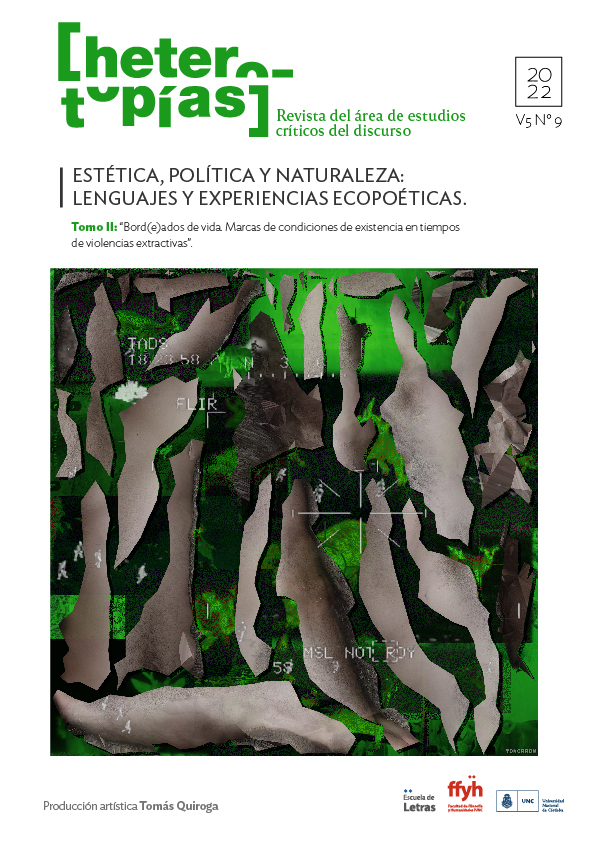Visual dialogues on neoextractivism Situated works and environmental conflicts in three contemporary female artists
Main Article Content
Abstract
The extractive model runs through the history of our continent since the beginning of colonization. Throughout these centuries, accumulation patterns have considered various modalities based on the development of monocultures distributed by regions, the extractive mining of metals and minerals, as well as the massive and systematic use of cheap labor. Since the beginning of the 21st century, productive reconversions consider new activities such as fracking, agribusiness and the extension of clearings with the consequent loss of biological and cultural diversity. Faced with these realities, the visual productions have been part of the collective responses, developing their own repertoires of resistance and resignification that in many cases show, denounce or recover from the materiality the crisis of the civilizing model.
The objective of this article seeks to review a set of contemporary artistic productions linked to the neoextractivist problem by presenting possible dialogues between the responses implemented by three female artists during the last decade: Marcela Magno, Diana Dowek and Dana Prieto.
Based on the material analysis of their works, it is sought to reconstruct the historical and political contexts of production, reviewing some of the artists' explorations in order to make visible political aesthetic experiences. From the need to incorporate a critical local perspective into the analyzes of the Anthropocene, the contribution refers to thinking about the specificities that the current configuration of ecopoetic and critical visual responses, fundamental when it comes to thinking more just and respectful worlds of the biodiversity.
Downloads
Article Details

This work is licensed under a Creative Commons Attribution-NonCommercial-ShareAlike 4.0 International License.
Those authors who have publications with this journal, accept the following terms: Those authors who have publications with this journal, accept the following terms:
a. The authors will keep their copyright and guarantee to the journal the right of first publication of their work, which will be simultaneously subject to the Creative Commons Attribution - Non-Commercial - Share Alike (by-nc-sa) Attribution License; no commercial use of the original work or any derivative works is allowed, the distribution of which must be done with a license equal to the one that regulates the original work.
b. Authors may adopt other non-exclusive license agreements for the distribution of the published version of the work (e.g., deposit it in an institutional telematic archive or publish it in a monographic volume) provided that the initial publication in this journal is indicated.
c. Authors are allowed and recommended to disseminate their work through the Internet (e.g. in institutional telematic archives or on their website) before and during the submission process, which may lead to interesting exchanges and increase the number of citations of the published work. (See The effect of open access).
References
Basualdo, E. (2018). Endeudar y fugar. Un análisis de la historia económica argentina de Martínez de Hoz a Macri. Buenos Aires: Ed. Siglo XXI.
Diana, D. (2015). La mirada de Ulises. Obras 2012-2014. Centro Cultural Recoleta. Recuperado de http://www.arsomnibus.com.ar/web/muestra/la-mirada-de-ulises-obras-2012-2014
Conese, I. (13 de julio, 2021). “Son las mineras o nosotros. No tenemos otra salida”. La historia de Andalgalá y su lucha por el agua. El País. Recuperado de https://elpais.com/planeta-futuro/2021-07-14/son-las-mineras-o-nosotros-no-tenemos-otra-salida-la-historia-de-andalgala-y-su-lucha-por-el-agua.html
Crutzen, P. (2002). La geología de la especie humana. Nature, 415, 23.
Didi-Huberman, G. (1997). Lo que vemos lo que nos mira. Editorial Manantial: España.
Didi-Huberman, G. (2009). La imagen superviviente. Historia del arte y tiempo de los fantasmas según Aby Warburg. Ed. Abada, Madrid.
Dowek, D. (2017). La pintura es un campo de batalla. Ed. Asunto Impreso: Buenos Aires.
Dubois, P. (2008). El acto fotográfico y otros ensayos. La Marca editora: Buenos Aires.
Herrera, J. M. (2014). Cien años de arte argentino. Ed. Biblios-Fundación OSDE: Buenos Aires.
Escobar, T. (2021). Aura Latente. Estética/Ética/Política/Técnica. Tinta Limón: Buenos Aires.
Magno, M. (2012). Land. Recuperado de: https://marcelamagno.com
Malm, A. y Hornborg, A. (2014). ¿La geología de la especie humana? Una crítica al discurso del Antropoceno. Traducción Gonzáles Valeria y Pablo Méndez. Recuperado de https://cck.gob.ar/una-critica-al-discurso-del-antropoceno-por-andreas-malm-y-alf-hornborg/4812/
Marchesi, M. (2019). Diana Dowek. Paisajes insumisos. Museo Nacional de Bellas Artes. Recuperado de: https://www.bellasartes.gob.ar/exhibiciones/diana-dowek-paisajes-insumisos/
Mauss, Marcel (1924). Ensayo sobre el don. Forma y función del intercambio en las sociedades arcaicas. Katz editores: Argentina.
Moore, J. (2015). El capitalismo en la trama de la vida. Ecología y acumulación del capital. Ed. Traficantes de Sueños: Madrid.
Morgan, J. (julio-agosto, 2018). Esta feria de arte es una fantasía poscapitalista. Revista THIS. Canadá. Recuperado de: https://this.org/2018/08/08/this-art-series-is-a-post-capitalist-fantasy/
Observatorio Petrolero Sur, E. D´Elia, P. Bertinat, M. Svampa, R. Ochandio, E. Viale (2014). 20 Mitos y realidades del fracking. Ed. El Colectivo: Buenos Aires.
Prieto, D. (2018). The fighters. Episodio 8. [Archivo de video]. Recuperado de https://www.youtube.com/watch?v=obw81fWZ4a4
Prieto, D. Recuperado de http://www.danaprieto.com/
Rouillé, A. (2017). La fotografía. Entre documento y arte contemporáneo. Herder: México.
Stengers, Isabelle (2009) 2017. En tiempos de catástrofes. Cómo resistir a la barbarie que viene. Futuro Anterior Ediciones: Buenos Aires.
Solas, S. (2021). El arte como pensamiento En: Soulages, F. y Erbetta, A. (comp.) El arte contemporáneo y, por lo tanto, la fotografía (p.21-26). Ediciones ArtexArte: Argentina.
Speranza, G. (2012). Atlas portátil de América latina. Arte y ficciones errantes. Anagrama- Kalifón: Buenos Aires.
Svampa, M. y Viale, E. (2016). Maldesarrollo: la Argentina del extractivismo y el despojo. Katz editores: Argentina.
Svampa, M. y Viale, E. (2020). El colapso ecológico ya llegó. Una brújula para salir del mal desarrollo. Siglo XXI editores: Buenos Aires.
Tsing A., Swanson H. y Gan E., Bubandt N. (2017). Artes de vivir en un planeta dañado: fantasmas y monstruos del Antropoceno. Minneapolis: University of Minnesota Press.
Ulloa, A. (mayo-agosto, 2017). Dinámicas ambientales y extractivas en el siglo XXI: ¿es la época del Antropoceno o del capitaloceno en América latina? Desacatos Revista de Antropología Social, (54), 58-73. Ciudad de México. Recuperado de http://www.scielo.org.mx/scielo.php?script=sci_arttext&pid=S1607-050X2017000200058
Villar, E. (diciembre 2015). Miradas que se completan. Transvisual, (9), 48-50. Buenos Aires. Recuperado de https://issuu.com/centro-cultural-recoleta/docs/transvisual_9
